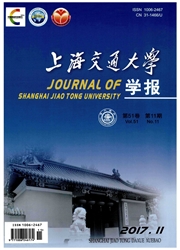

 中文摘要:
中文摘要:
采用3种热处理工艺研究了Au—Cu—Al合金母相的有序化程度,分析了其A2→B2→L21的有序化转变对马氏体转变的影响,即其相变点、马氏体和母相的结构,以及400℃时效炉冷处理后没有生成马氏体的原因.结果表明,采用100℃时效1.5h后淬火到冰水中(热处理工艺Ⅱ)的热处理工艺,可以得到表面浮突的马氏体;采用从650℃直接淬火到液氮中(热处理工艺Ⅰ)的热处理工艺,也会发生马氏体转变,且其均为bct结构,时效处理可使母相得到充分有序化,从而提高其马氏体转变点温度,并使马氏体转变更加充分;此外,采用400℃时效、炉冷处理并淬火(热处理工艺Ⅲ)的热处理工艺,可以获得更高的母相有序度,且不会导致马氏体相变,其所产生的bct结构的新相可能是通过形核长大转变而来.
 英文摘要:
英文摘要:
Three heat treatment processes were carried out to study the ordering of the parent phases in Au- Cu-Al alloys. The influence of its A2-B2-L21 ordering transformation on martensitic transformation were analyzed, which contains the starting martensitic transformation temperatures(Ms), the structure of martensite and parent phases and the reason why no martensitic transformation was produced after 400℃ annealing followed by cooling with furnace. The results indicate that the sample that aged at 100℃ for more than lh and then quenched into ice water (Heat treatment processⅡ), can transform to martensite and show surface relief, as well as the sample directly quenched into liquid nitrogen from 650℃ (Heat treatment process Ⅰ). Both of their structures are body-centered tetragonal (bct). During the aging process, the parent phase gets more ordered, and consequently the Ms is greatly lifted. Therefore, the parent phase transforms to martensite more completely. In addition, as the sample aged at 400℃for 2 h and then cooled with furnace (Heat treatment process Ⅲ). A more ordered parent phase can be obtained, which probably transforms to a new phase with bct structure through the nucleation and growth mechanism.
 同期刊论文项目
同期刊论文项目
 同项目期刊论文
同项目期刊论文
 Microstructures and mechanical properties of 50SiMnNiNb steel by a novel quenching-partitioning-aust
Microstructures and mechanical properties of 50SiMnNiNb steel by a novel quenching-partitioning-aust 期刊信息
期刊信息
